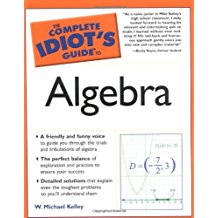Algebra: Factoring Trinomials Using Their Coefficients
Factoring Trinomials Using Their Coefficients
Now that you've learned how to factor out greatest common factors and can recognize important factor patterns, it's time to introduce the third most common factoring skill you'll need in algebra: factoring trinomials whose terms contain consecutive powers. (In other words, the exponents of the variables come one right after the other, like 0, 1, 2 or 3, 4, 5.) I'll spend the rest of this section dealing with this topic.
In this section, I'll describe a technique that does a great job of factoring trinomials whose leading coefficient is 1. In the final section, I'll tell you how to handle polynomials with different leading coefficients.
The vast majority of the trinomials you'll factor are quadratic. In other words, you'll factor something that looks like this:
- x2 + ax + b, where a and b are integers
(If you're wondering why there's no variable coefficient on the x2 term, remember that the x2's coefficient is also the leading coefficient for the polynomial, and it needs to be 1 for this technique to work properly.)
Your goal will be to factor that trinomial into two binomials that look like this:
- (x + ?)(x + ?)
Critical Point
When you're trying to figure out what goes into the boxes to factor x2 + ax + b, pay special attention to the signs of a and b. If b is positive, then the mystery numbers are either both positive or both negative. If b is negative, then one of the mystery numbers must be positive and the other must be negative.
So, all you have to do is figure out what numbers go in those boxes. Here's the trick. If the trinomial x2 + ax + b is factorable, then two numbers will exist whose sum is a (the coefficient of the x term) and whose product is b (the constant). All you have to do is experiment until you figure those numbers out.
Critical Point
Another way to find the mystery numbers in Example 4(b) is to start with the constant, rather than the x coefficient. Instead of trying pairs of numbers that add up to -3, try pairs of numbers whose product is -54.
Once you know what they are, plug each one into its own box (it doesn't matter which one), and you're done!
You've Got Problems
Problem 4: Factor the polynomial 2x3 - 24x2 + 64x. Hint: Once you factor out the greatest common factor, it will look like the problems in Example 4.
Example 4: Factor the polynomials.
- (a) x2 + 7x + 12
- Solution: Ask yourself, "What two numbers add up to 7 but multiply to give you 12?" Since 12 is positive, both mystery numbers must be positive or negative, as I explained in a nearby margin note. Furthermore, since the sum of the mystery numbers, a, is also positive, then the only logical conclusion is that the numbers you seek must both be positive. (There's no way to add up two negative numbers to get a positive sum.)
- It helps to follow a pattern if the answer doesn't dawn on you right away. Since you know the sum is 7, try two basic positive numbers whose sum is 7: 6 + 1. However, 6 · 1 12, so that's not right. Okay, so try 5 + 2 next; those numbers also have a sum of 7. Unfortunately, 5 · 2 = 10, which is not right, but it's a lot closer to the product you're looking for.
- Next try 4 + 3. Hey ¦ this looks good. The sum is 7 and 4 · 3 = 12. Bingo! All you have to do is plug those numbers into (x + ?)(x + ?) and you're done: (x + 3)(x + 4). Since multiplication is commutative, you could also have given an answer of (x + 4)(x + 3) and been equally correct.
- (b) w2 - 3w - 54
- Solution: Even though you've got w's instead of x's, the process is the same. Your answer will just have w's instead of x's. Since the constant, -54, is negative, you know one of the mystery numbers is positive and one is negative. In addition, they should add up to -3, so you can also surmise that the negative number is bigger than the positive number.
If you can't figure out where to start, try the procession of terms with sum -3: -4 + 1, -5 + 2, -6 + 3, etc. You'll eventually get the numbers -9 and 6, which have the correct sum and product, so the factored form of the polynomial is (x - 9)(x + 6).

Excerpted from The Complete Idiot's Guide to Algebra © 2004 by W. Michael Kelley. All rights reserved including the right of reproduction in whole or in part in any form. Used by arrangement with Alpha Books, a member of Penguin Group (USA) Inc.
You can purchase this book at Amazon.com and Barnes & Noble.
